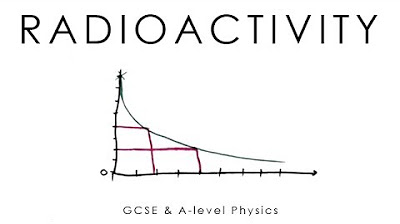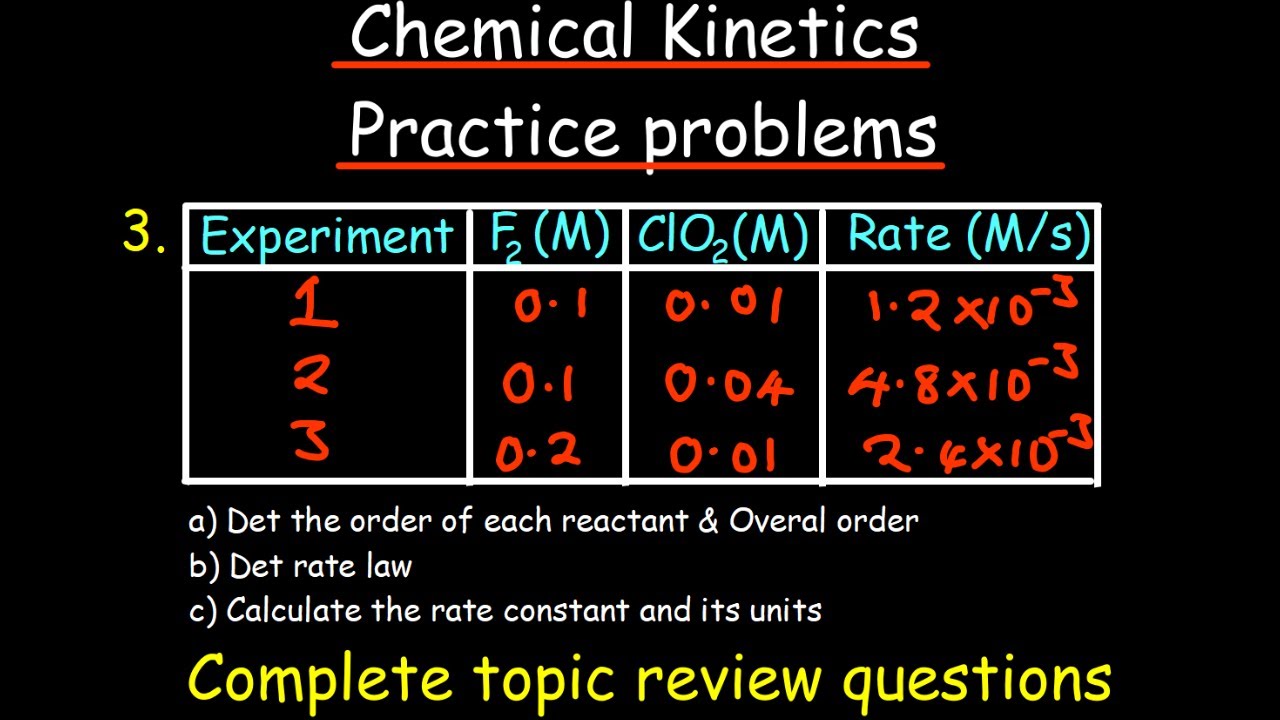15.4 Kinetics of Nuclear Decay | High School Chemistry
TLDRThis lesson delves into the kinetics of nuclear decay, highlighting it as a first-order process with exponential decay. It introduces the concept of half-life and its significance in radioactive decay. The instructor explains the mathematical equations for decay and discusses radiocarbon dating, focusing on carbon-14's role in dating once-living organisms. The script also covers how to calculate the age of an archaeological artifact using the decay of carbon-14, providing a practical example with calculations.
Takeaways
- 🔬 Nuclear decay is a first-order process characterized by exponential decay, with the rate constant 'k' and time 't' playing key roles in the decay equations.
- 📉 The script introduces two forms of the decay equation: one in exponential form and another derived by taking the natural logarithm, both describing the decay of a radioactive substance over time.
- ⏳ The concept of half-life is central to nuclear decay, defined as the time it takes for half of a radioactive sample to decay, with each element having a characteristic half-life ranging from seconds to billions of years.
- 📊 The decay process can be visualized in terms of mass, percentages, fractions, or radioactivity, such as disintegrations per minute, to quantify the remaining radioactive material.
- 🌳 Radiocarbon dating, specifically using Carbon-14, is a method to determine the age of once-living materials by measuring the remaining activity of Carbon-14 compared to living organisms.
- 🚫 Radiocarbon dating is limited to materials that were once part of living organisms and cannot be used to date inanimate objects like rocks, unless they contain fossilized organic material.
- ☢️ Carbon-14 is produced in the atmosphere when cosmic rays interact with Nitrogen-14, and it eventually becomes part of the carbon cycle, being incorporated into living organisms before reaching equilibrium.
- 📉 The half-life of Carbon-14 is approximately 5730 years, which is used to calculate the age of archaeological samples by comparing their Carbon-14 activity to that of contemporary life.
- 🔢 The script demonstrates how to calculate the age of a sample using the decay equation and the known half-life of Carbon-14, highlighting the process of solving for time 't'.
- 📚 The lesson is part of a high school chemistry playlist, with new lessons released weekly, and the speaker encourages viewers to subscribe for updates.
- 📈 The script also mentions other radiometric dating techniques suitable for dating rocks and other non-organic materials, such as uranium-lead or potassium-argon dating.
Q & A
What is the main topic of the lesson?
-The main topic of the lesson is the kinetics of nuclear decay, specifically focusing on how nuclear decay is a first-order process that undergoes exponential decay.
What are the two forms of equations mentioned for treating nuclear decay mathematically?
-The two forms of equations mentioned are: the exponential decay equation and its logarithmic form.
What is the half-life in the context of nuclear decay?
-The half-life is the time it takes for half of a radioactive sample to decay.
How does the decay process of a radioactive substance behave over time?
-The decay process behaves exponentially, meaning the quantity of the substance decreases by half during each half-life period.
Can you explain how to calculate the remaining amount of a radioactive substance after multiple half-lives?
-Yes, to calculate the remaining amount, you divide the initial quantity by 2 for each half-life period. For example, if you start with 100 grams and the half-life is 20 minutes, after 1 half-life (20 minutes) you'll have 50 grams, after 2 half-lives (40 minutes) you'll have 25 grams, and so on.
How does the amount of radioactive carbon-14 change in living organisms versus in dead ones?
-In living organisms, the amount of radioactive carbon-14 remains constant due to continuous intake. In dead organisms, the intake stops, and the existing carbon-14 undergoes radioactive decay, decreasing over time.
What is the half-life of carbon-14?
-The half-life of carbon-14 is 5730 years.
Why is carbon-14 dating only effective for dating things that were once alive?
-Carbon-14 dating is only effective for things that were once alive because it relies on the intake of carbon-14 through the process of photosynthesis and consumption, which stops upon death. Rocks or other non-living things do not take in carbon-14.
How can you approximate the age of an archaeological sample using carbon-14 activity?
-To approximate the age, compare the carbon-14 activity in the sample to the activity in living organisms today. Use the known half-life of carbon-14 to calculate the elapsed time based on the decrease in activity.
What is the significance of the rate constant 'k' in nuclear decay equations?
-The rate constant 'k' in nuclear decay equations is related to the speed of the decay process. It can be calculated using the half-life and is used in the exponential and logarithmic decay equations to determine the amount of substance remaining at any given time.
What are some of the units used to measure radioactivity mentioned in the lesson?
-Some units mentioned for measuring radioactivity are becquerel, curie, rad, rem, gray, and disintegrations per minute.
How can you solve for the time elapsed if you know the initial and remaining amounts of a radioactive substance?
-You can solve for the time elapsed using the logarithmic form of the decay equation: ln(N/N₀) = -kt, where N is the remaining amount, N₀ is the initial amount, k is the rate constant, and t is the time.
Outlines
🔬 Nuclear Decay and First Order Kinetics
This paragraph introduces the concept of nuclear decay, focusing on its nature as a first order process characterized by exponential decay. It explains the mathematical treatment of this process, including the use of equations to represent the decay over time. The half-life of a radioactive sample, the time required for half of the sample to decay, is discussed, along with radiometric dating techniques such as radiocarbon dating. The paragraph also highlights the educational context, mentioning a high school chemistry playlist and the release schedule for the video lessons.
📈 Understanding Radioactive Decay Equations and Half-Life
The paragraph delves deeper into the equations that describe first order decay, emphasizing their exponential nature and the variables involved, such as the current amount of radioactive substance (n), the initial amount (n₀), the rate constant (k), and time (t). It also discusses the concept of half-life with examples, illustrating how the quantity of a radioactive substance reduces by half with each passing half-life period. The paragraph further explores different ways to represent decay, including mass, percentages, and fractions, and mentions various units of radioactivity, focusing on disintegrations per minute as a measure of activity.
🌱 Radiocarbon Dating and the Role of Carbon-14
This section discusses radiocarbon dating, specifically the use of carbon-14 to date once-living organisms. It explains the abundance of carbon isotopes in nature, the origin of carbon-14 from nitrogen-14 through cosmic ray interaction, and its incorporation into living organisms through the food chain. The paragraph describes how equilibrium of carbon-14 is maintained in living organisms and how its decay can be used to time-stamp the death of organisms, making it a valuable tool for dating archaeological and biological samples. It also touches on the limitations of radiocarbon dating, such as its upper age limit and decreasing accuracy with time.
📊 Calculating Age Using Radiocarbon Dating
The final paragraph provides a practical example of calculating the age of an archaeological sample using radiocarbon dating. It explains the process of determining the rate constant from the known half-life of carbon-14 and using it to calculate the time elapsed since the organism's death. The paragraph demonstrates the calculation using the given activities of carbon-14 in the sample and in living organisms, resulting in an approximate age of the sample. It also mentions the increasing approximation with age and the practical applications of this dating method, concluding with a call to action for viewers to engage with the content and explore additional resources.
Mindmap
Keywords
💡Nuclear Decay
💡First Order Process
💡Exponential Decay
💡Half-Life
💡Radiocarbon Dating
💡Carbon-14
💡Rate Constant
💡Disintegrations Per Minute
💡Natural Logarithm
💡Radioactivity
💡Equilibrium
Highlights
The lesson discusses the kinetics of nuclear decay as a first-order process with exponential decay.
Introduction of two mathematical equations to describe first-order decay in nuclear processes.
Explanation of the rate constant 'k' and its relation to the speed of nuclear decay.
Definition and significance of half-life in radioactive decay.
Illustration of half-life with an example of a radioactive substance decaying over time.
Different ways to represent decay: mass, percentage, fractions, and radioactivity.
Introduction of radioactivity units such as Becquerel, Curie, and disintegrations per minute.
Application of half-life to calculate the remaining mass of a radioactive substance after a given time.
How to determine the half-life of a substance given its decay over time.
Radiocarbon dating technique and its reliance on Carbon-14.
The abundance of Carbon-12 and Carbon-13 in nature compared to the trace amounts of Carbon-14.
Cosmic rays' role in the formation of Carbon-14 from Nitrogen-14.
Equilibrium of Carbon-14 in living organisms and its use in dating once-living materials.
Limitations of radiocarbon dating to approximately 50,000 years due to the diminishing amount of Carbon-14.
Calculation of the approximate age of an archaeological sample using Carbon-14 activity and its half-life.
The relationship between the half-life and the rate constant in radioactive decay calculations.
Practical example of calculating the age of cloth using its Carbon-14 activity compared to modern organisms.
Importance of understanding the logarithmic properties in calculating decay and half-life.
Transcripts
Browse More Related Video

Half-life and carbon dating | Nuclear chemistry | Chemistry | Khan Academy

Introduction to exponential decay | Nuclear chemistry | Chemistry | Khan Academy

Radioactivity, Half-Life & Inverse Square Law - GCSE & A-level Physics (full version)

Half-Life and Radioactive Decay

Alpha Decay, Beta Decay, Gamma Decay - Electron Capture, Positron Production - Nuclear Chemistry

Chemical Kinetics practice problems - complete review
5.0 / 5 (0 votes)
Thanks for rating: